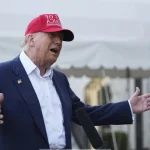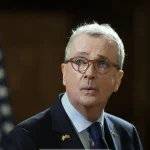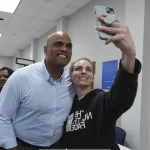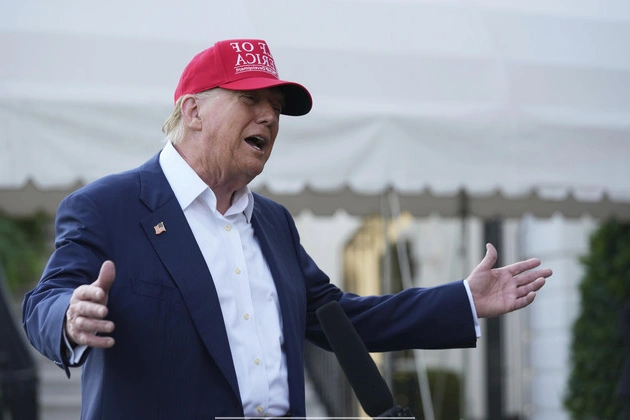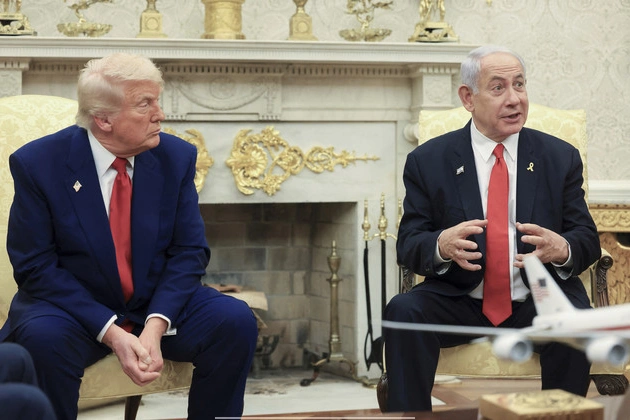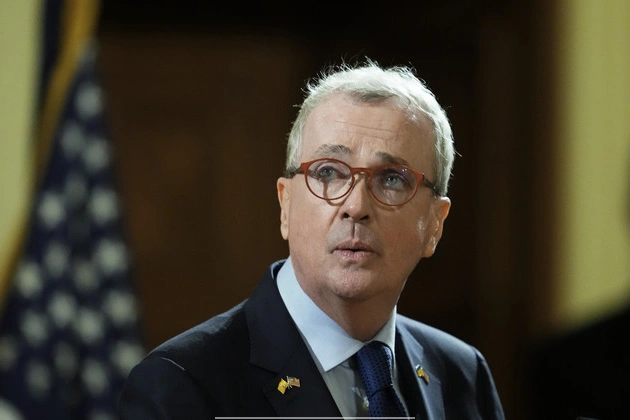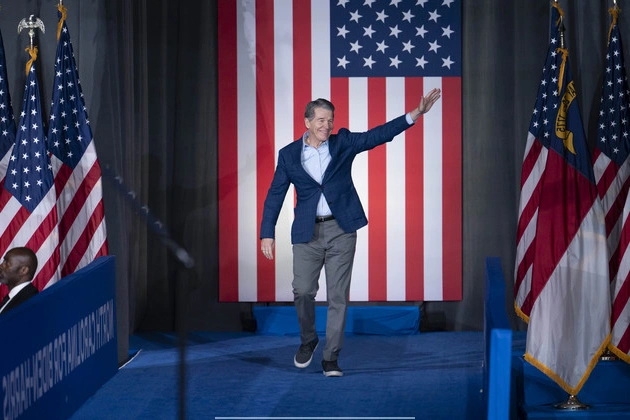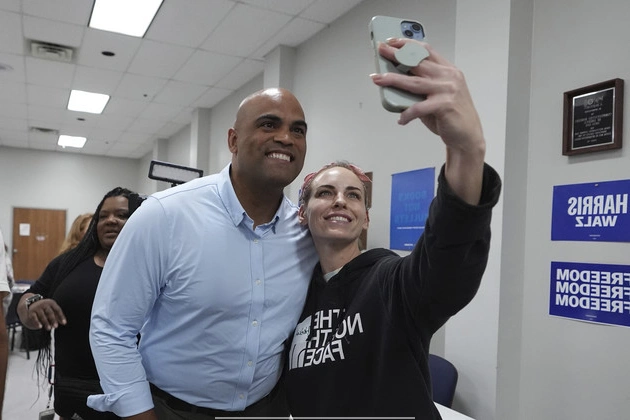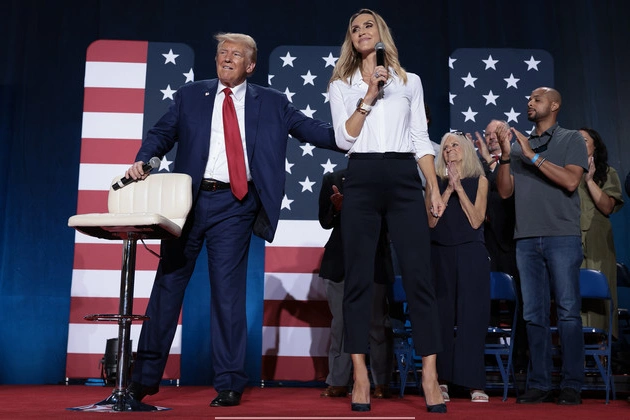
President Donald Trump has embraced testing his executive authority during his first 100 days back in office.
During his comeback campaign, Trump made sweeping promises centered on “America first” policy: a crackdown on immigration, an overhaul of the federal government, a drop in grocery prices, global tariffs, the end of wars and elimination of DEI programs, among others.
In many cases, Trump has kept the promises he ran on. But to do so, he has tested the balance of power, pushing up against Congress, the courts and other guardrails. Doing so could hamper his ability to make changes permanent — or meaningfully enact them at all.
A tally of some of Trump’s most notable promises finds that the president kept nine pledges and broke four. Whether he has fulfilled another nine is still to be determined and six promises were fulfilled to only some degree. Several of the president’s first orders have been blocked by the courts.
On immigration, Trump declared a national emergency at the U.S.-Mexico border and has seen border crossings plummet during his first 100 days, a fulfillment of his pledge. But he has also struggled to deport undocumented immigrants at the rates he promised.
Other promises have proven more difficult to fulfill: He told voters he would lower grocery prices — including the cost of eggs — even though presidents don’t have much authority to directly address them. His policies may even be making them worse as tariffs on products like coffee, chocolate and bananas as well as aluminum from China — critical for beer and soup cans — are expected to make prices rise.
“In his first 100 days, President Trump has delivered on hundreds of promises and already accomplished his two most important campaign goals — the border is secure and inflation is ending,” White House press secretary Karoline Leavitt said. “The next 100 days will consist of trade deals, peace deals and tax cuts. More American greatness is on the way.”
Here’s a look at Trump’s first 100 days in office.
Trump took the unprecedented step of eschewing federal funding for his presidential transition, which allowed him to sidestep the mandatory disclosure requirements every administration in modern history has followed and accept unlimited donations from individuals and corporations. Although his team pledged to voluntarily disclose the private funds they received to finance the massive turnover of power from former President Joe Biden, Trump has yet to do so.
The president didn’t impose any tariffs on his first day, although he signed a lengthy executive order launching a number of trade probes. In February, he rolled out new 25 percent tariffs on Canada and Mexico, but later paused and then suspended the majority of them indefinitely. Still, Trump did follow through on an added 10 percent tariff on Chinese goods in February, which he has since raised to a whopping 145 percent in a tit-for-tat escalation with Beijing.
On April 2, the president rolled out a 10 percent baseline tariff on all imports — erecting a significant new trade barrier for exports to the U.S. that is forecast to reduce global trade and increase prices. On China, he went well past 60 percent, eventually setting a 145 percent tariff on goods from the world’s second-largest economy.
Trump signed an executive order on Inauguration Day directing Cabinet officials to “investigate the feasibility of establishing” an External Revenue Service. A report was due April 1. The White House has yet to announce any further action, but Trump posted over the weekend on Truth Social: “THE EXTERNAL REVENUE SERVICE IS HAPPENING!!!”
Congressional Republicans are assembling a far-reaching bill that would extend the 2017 tax cuts, which would otherwise expire at the end of 2025. Trump has also proposed numerous add-ons, including ending taxes on tips, overtime pay and Social Security benefits. However, it comes with a huge price tag, and GOP lawmakers have been squabbling about the cost.
Inflation has not ended, but the news has been pretty good of late: prices, as measured by the Consumer Price Index, rose 2.4 percent over the 12 months ended in March, compared to a 2.8 percent reading in February. Even excluding more volatile food and energy prices, inflation rose less than expected that month. However, that good news isn’t expected to last. Those numbers are a snapshot of the economy before Trump’s widespread new tariffs, which will raise costs for companies and could lead to price spikes for American consumers.
Amid questions around inflation and tariffs, this promise is looking more and more uncertain. The stock market — once the president’s favored economic barometer — plunged in the wake of his so-called Liberation Day. And while it has pared some of those losses, the S&P 500 is still down about 8 percent since he took office. His advisers are urging patience, but the sell-off has already dented plenty of Americans’ retirement savings.
The president issued an executive order in March directing Education Secretary Linda McMahon to take steps toward closing her agency. Fully shuttering the department would need congressional approval. But the Trump administration cut the Education Department’s workforce nearly in half. McMahon said she would present lawmakers with a plan to close the agency that lawmakers could get on board with and several congressional Republicans have introduced or are expected to introduce legislation to shut down the agency. Several congressional Republicans have, or are planning to, introduce such bills but passage is a long shot.
Trump signed an executive order in February blocking transgender athletes from participating in women’s sports. Since then, the Trump administration has leveraged that order to compel states and schools to bar transgender students from women’s sports teams — threatening to pull federal funds for what the administration says is a violation of Title IX, the federal civil rights law protecting against sex-based discrimination.
It didn’t take long for the Securities and Exchange Commission to begin orchestrating the regulatory U-turn on crypto. The Wall Street regulator quickly dropped more than a dozen lawsuits and investigations against companies like Coinbase, Kraken and Robinhood, while moving to settle others. It rebranded its crypto enforcement unit and transferred one of the unit’s top attorneys working on crypto cases to its information technology office. The Justice Department has similarly disbanded its crypto enforcement team.
Trump blew past all the analysts — and his vice president — who suspected he would pardon a few of the roughly 1,600 people charged or convicted for storming the Capitol but refrain from granting reprieves to the most violent or seditious members of the mob. Instead, Trump leaned in as aggressively as possible: On his first day, he pardoned more than 1,000 defendants, erased hundreds of additional pending cases and commuted the sentences of about a dozen people convicted of seditious conspiracy. The clemency was so sweeping and vaguely worded that some Jan. 6 defendants are attempting to use it to erase crimes that had nothing to do with the attack on the Capitol, which is causing some courts to balk.
In February, Trump signed an executive order that urges federal officials to study the issue and generate policy proposals. Though the EO does not make any policy or spending changes related to IVF, some conservative leaders — many who have otherwise cheered his reproductive health policies — have said the administration risks promoting a practice they view as akin to abortion.
In his first days in office, Trump signed an executive order threatening the federal funding of providers that “fund, sponsor, promote, or assist” young people in transitioning from their sex assigned at birth. However, two federal judges have since temporarily blocked the order.
The war between Ukraine and Russia continues to rage. Deadly Russian strikes on civilians in Kyiv took place just as Trump envoy Steve Witkoff visited Moscow last week, underscoring how many setbacks Trump has faced on a peace deal. But Trump hasn’t abandoned his efforts. He met with Ukrainian President Volodymyr Zelenskyy on the sidelines of Pope Francis’ funeral last weekend.
The White House issued an executive order on Jan. 27 offering troops discharged under the policy the option to rejoin with back pay. Around 8 percent of those who left the military had returned as of early March.
On his first day back in the White House, Trump revoked Biden-era orders allowing transgender people to serve openly. The Pentagon then issued a directive to remove transgender troops from the military. But two federal judges have blocked Trump’s effort, and the administration is asking the Supreme Court to allow the ban to be enforced.
Trump in January signed an executive order directing the Defense Department to terminate diversity programs and offices. The Pentagon not only followed on that but also erased references to minority service members from its websites and disbanded affinity groups at military academies. The administration also dismissed Gen. CQ Brown, the first Black chair of the Joint Chiefs; Adm. Lisa Franchetti, the first woman to serve as chief of naval operation; Adm. Linda Fagan, the first female Coast Guard commandant, and Vice Adm. Shoshana Chatfield, a representative to NATO listed among “woke” officers by a conservative group.
The Trump administration has reversed the renaming of two Army bases but with a twist. Defense Secretary Pete Hegseth renamed North Carolina’s Fort Liberty to Fort Bragg, though not for its original namesake, Confederate Gen. Braxton Bragg. Instead, the Pentagon chief renamed the installation for Army Private First Class Roland Bragg, who earned a Silver Star and Purple Heart for his actions at the Battle of the Bulge during World War II.
A second base, Georgia’s Fort Moore, was renamed to Fort Benning in honor of Army Corporal Fred Benning, who received the Distinguished Service Cross for his service in World War I. The base was originally named for Confederate Brig. Gen. Henry Benning.
Trump did sign an executive order attempting to unilaterally end birthright citizenship, but three federal judges issued nationwide injunctions blocking it saying it violates the 14th Amendment. The Supreme Court will hear arguments in May on the president’s bid to begin enforcing this EO as they weigh the authority of lower court judges to issue broad injunctions blocking the president’s policies nationwide.
Trump did take steps toward implementing a new travel ban in his Day One EOs, including signing an executive order that directed agencies to identify countries where vetting visitors and visa applicants is considered infeasible and poses a potential threat to national security. But while the administration has circulated draft lists, they’ve yet to release the sweeping travel ban Trump promised.
Trump has captured national attention with high-profile deportations and clashes with the courts. But he hasn’t been able to remove undocumented immigrants from the country at the speed and scale he promised due to funding and staffing challenges, as well as a bogged down immigration court system. Using budget-reconciliation, Republican lawmakers are working to fuel Immigration and Customs Enforcement with a major funding increase.
Trump quickly clamped down on the southern border, and between stricter policies and his sharp rhetoric, illegal border crossings have plummeted to their lowest level in decades.
Trump declared a national emergency at the nation’s southern border on Day One. He also quickly deployed troops to the border, and border czar Tom Homan said this week that they’re still working to ramp up Defense Department facilities like Fort Bliss to detain more migrants. Trump aides and allies have also discussed using the Insurrection Act to activate state National Guardsmen and federal troops to bolster ICE’s ranks.
Declaring an energy emergency was among several executive orders Trump signed on Inauguration Day. He also signed missives pulling the U.S. out of the Paris climate agreement, freezing regulatory work and seeking to undo former President Joe Biden’s recent withdrawal of vast swaths of ocean for oil and natural gas drilling.
But Trump’s definition of energy production in the executive order excludes wind and solar energy, the fastest-growing sources on the power grid. That means Trump’s policies could drive up energy prices and greenhouse gas emissions if agencies are forced to speed up approvals for fossil fuel projects while downplaying renewables.
The Green New Deal, a suite of left-leaning climate-friendly policies, never became law but Trump’s EPA Administrator Lee Zeldin has targeted hundreds of grants issued by the Biden administration under the Inflation Reduction Act and other authorities. Zeldin’s most prominent effort is his attempt to claw back $20 billion under the Greenhouse Gas Reduction Fund that have hit roadblocks in court.
The fate of the Inflation Reduction Act’s clean energy tax credits remains the subject of debate in Congress between conservatives and moderates who fear cutting them will jeopardize the manufacturing and power projects the Democrats’ law is creating in their states and districts.
Trump quickly rattled federal workers — which he and his allies derisively refer to as the “deep state” — and Washington broadly by reinstating a method to make it easier to fire or control federal employees who play a role in policymaking. The Office of Personnel Management in April formally proposed a regulation to enshrine the move, called Schedule Policy/Career.
The regulatory maneuver has been dwarfed by Elon Musk, OMB Director Russell Vought and others: stripping collective bargaining rights from staff at entire agencies on national security grounds; unilaterally invaliding contract provisions on telework; moving to fire large swaths of fresh hires and newly promoted workers; sidelining staffers by vastly expanding the use of paid administrative leave; and instituting large-scale layoffs in an effort to shrink the size of government.
Many of those directives have been challenged in court with mixed results for Trump.
Trump signed an executive order on Inauguration Day revoking Biden’s AI guidance, shifting the executive branch’s focus from protecting safety and civil rights to ensuring American market dominance and national security in a globally competitive — though still-developing — technology. Trump also ordered the creation of his own AI action plan by July, however, his administration has yet to release a detailed replacement strategy.
Food prices have continued to tick upward since Inauguration Day, rising 2.4 percent in March year-over-year. From 2020 to 2024, food prices rose 24 percent, forcing more Americans to turn to food banks and other emergency options. Trump’s tariffs targeting foods like coffee, chocolate and bananas as well as aluminum from China — critical for beer and soup cans — also stand to raise prices further.
***
